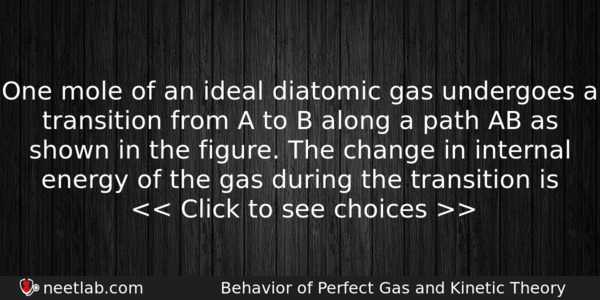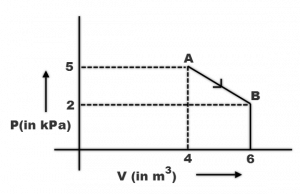| ⇦ | 
| ⇨ |
One mole of an ideal diatomic gas undergoes a transition from A to B along a path AB as shown in the figure.

The change in internal energy of the gas during the transition is
Options
(a) -20 kJ
(b) 20 J
(c) -12 kJ
(d) 20 kJ
Correct Answer:
-20 kJ
Explanation:
No explanation available. Be the first to write the explanation for this question by commenting below.
Related Questions: - In a discharge tube ionization of enclosed gas is produced due to collisions between
- In cyclotron, for a given magnet, radius of the semicircle traced by positive ion
- In depletion layer of unbiased P-N junction
- Following figures show the arrangement of bar magnets in different configurations
- A disc of mass 100 g is kept floating horizontally in air by firing bullets
Topics: Behavior of Perfect Gas and Kinetic Theory
(34)
Subject: Physics
(2479)
Important MCQs Based on Medical Entrance Examinations To Improve Your NEET Score
- In a discharge tube ionization of enclosed gas is produced due to collisions between
- In cyclotron, for a given magnet, radius of the semicircle traced by positive ion
- In depletion layer of unbiased P-N junction
- Following figures show the arrangement of bar magnets in different configurations
- A disc of mass 100 g is kept floating horizontally in air by firing bullets
Topics: Behavior of Perfect Gas and Kinetic Theory (34)
Subject: Physics (2479)
Important MCQs Based on Medical Entrance Examinations To Improve Your NEET Score
18000+ students are using NEETLab to improve their score. What about you?
Solve Previous Year MCQs, Mock Tests, Topicwise Practice Tests, Identify Weak Topics, Formula Flash cards and much more is available in NEETLab Android App to improve your NEET score.
Share this page with your friends

ΔU = nCΔT
Also, T = PV/nR
Now,
ΔT = T-T => [PV – PV] / nR
ΔU = nR/¥-1 {PV- PV / nR} [here, ¥ = gamma]
(nR will be cancelled out)
We get,
{-8 x 10^3} / {2/5} = -20kJ.
Hope it helps 🙂